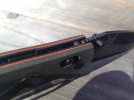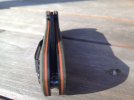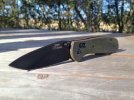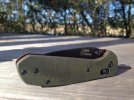First post here. Lurked around for as long as I can remember. Love the forum and decided to join when I couldn't find answers to specific things. To begin, I apologize if this is in the wrong place. Besides that, I have been very interested in making custom scales. I have modified scales many times but never made them. I'm curious as to how one goes about making a two piece g10 or Micarta scale. Tuffthumbz made some awesome ruby and silver scales for his rajah 2. I was curious about doing something similar. How does one go about this? Any help is appreciated. Thanks in advance 
-
The BladeForums.com 2024 Traditional Knife is available! Price is $250 ea (shipped within CONUS).
Order here: https://www.bladeforums.com/help/2024-traditional/
You are using an out of date browser. It may not display this or other websites correctly.
You should upgrade or use an alternative browser.
You should upgrade or use an alternative browser.
Custom Scale Making
- Thread starter DJN
- Start date
This is three pieces per scale....




Not exactly sure what you are asking to know, but for a first set I would recommend a one piece scale per side. You will learn a lot on your first attempt if it doesn't find it's way to the trash can. I would also recommend buying extra material for a mistake or two. Other than that you will need a dremel with some mill type bit, cut-off wheel bit (if you choose to rough cut with the dremel), drill with assorted bits for pilot holes and final dimension, sand paper (various grits depending on your finish tastes), and do some reading on the customized threads. There is a good one on the Benchmade forum..."customized benchmades."
If you must attempt multiple pieces per scales you will need to epoxy them together. G-flex marine epoxy comes recommended by several.
That's about all I got for starters as I have only made a hand full of scales. Good Luck!




Not exactly sure what you are asking to know, but for a first set I would recommend a one piece scale per side. You will learn a lot on your first attempt if it doesn't find it's way to the trash can. I would also recommend buying extra material for a mistake or two. Other than that you will need a dremel with some mill type bit, cut-off wheel bit (if you choose to rough cut with the dremel), drill with assorted bits for pilot holes and final dimension, sand paper (various grits depending on your finish tastes), and do some reading on the customized threads. There is a good one on the Benchmade forum..."customized benchmades."
If you must attempt multiple pieces per scales you will need to epoxy them together. G-flex marine epoxy comes recommended by several.
That's about all I got for starters as I have only made a hand full of scales. Good Luck!
Heads up on the g10 wear proper safety gear g10 is very harmful to your health if your not wearing breathing protection when you cut and sand it parts of it will be breathed in. And cover yourself completely too when working with that stuff as I believe it has glass or fiberglass particles which will dig into your skin and annoy you to no end from what I hear. Other people can probably chime in and provide more info on that as I've never modded or built a knife scale before.
And out of curiosity are you planning on building the scales from scratch or buying a slab of material and cutting down to size?
And out of curiosity are you planning on building the scales from scratch or buying a slab of material and cutting down to size?
Elite_KG: My mistake. They are actual bolsters, not siilver G10... like this http://youtu.be/89F6ZXMUdbE?t=6m32s how difficult is it to make bolsters?
Bob6794: I have read the same! Thanks though, I'll make sure not to injure myself . No I do not have the slightest clue as to how to make the scales from absolute scratch, I intend on purchasing blanks or a slab
. No I do not have the slightest clue as to how to make the scales from absolute scratch, I intend on purchasing blanks or a slab
Bob6794: I have read the same! Thanks though, I'll make sure not to injure myself
Even harder than layering. The mating ends of the two materials have to be cut perfectly or cut then hand sanded to mate perfectly with no gaps. Another thing is will they sit on steel knife liners or a g-10 backing liner? If on the steel knife liner, you will need to ensure a faster is present in your knife or rely on the pivot pin to anchor the bolster. If on a g-10 liner, then you can epoxy the bolster and scale to the g-10 and mount as one scale piece (this may be somewhat easier and more stable).
Either way, you are embarking on a time consuming, tedious and challenging task for what may be your first attempt. If you are pretty good with your hands and practical at your approach you may be successful. Otherwise you may spend about as much money as to have someone make them for you only to throw your efforts in the can.
Only you will know where you stand. The materials and tools any specialized tools will likely cost as much as just one set made by someone else here on the forum (not me: I don't make for others. I just tinker with my stuff.)
Again whatever your choose, good luck.
Either way, you are embarking on a time consuming, tedious and challenging task for what may be your first attempt. If you are pretty good with your hands and practical at your approach you may be successful. Otherwise you may spend about as much money as to have someone make them for you only to throw your efforts in the can.
Only you will know where you stand. The materials and tools any specialized tools will likely cost as much as just one set made by someone else here on the forum (not me: I don't make for others. I just tinker with my stuff.)
Again whatever your choose, good luck.
I suggest starting at the beginning going solid scales only. However, should you make bolsters, use the factor edge cuts on the G10 for a more precise match up. It also helps to glue both pieces to a thin liner (I suggest G/flex 2 part epoxy from alphaknifewupply.com). The only tools you really need are a drill (drill press is more precise), rotary tool (doesn't have to be an expensive Dremel, Black and Decker RTX works fine and is only $30 and fits all Dremel bits, including the Dremel chuck), sanding and cutting disks for said rotary tool, a respirator (I suggest a 3M 6000 or 7000 series with P100 filters), and goggles.
I forgot drill bits... this differs from knife to knife...
I forgot drill bits... this differs from knife to knife...
